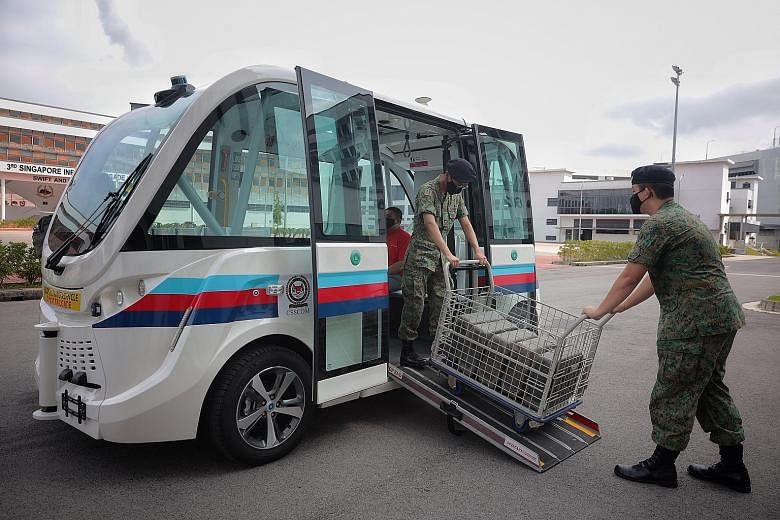Trials of driverless vehicles started last month at Singapore Armed Forces (SAF) sites.
The aim is to reduce manpower needs and offer more convenience to servicemen.
Four fully electric vehicles are being tested at Kranji Camp III and Paya Lebar Air Base to transport supplies and servicemen for at least a year.
They will perform scheduled services along pre-programmed routes and provide on-demand services with designated stops through a mobile app that will be developed.
If the trials are successful, the vehicles could be used across SAF camps in the future.
Military Expert 6 Jason Sim, head of system development at the army's Headquarters Transport, said deploying the autonomous vehicles (AVs) allows manpower resources required for administrative runs to be reduced.
"This manpower resource can be better deployed for operations and training support. Implementation of the AVs will also gain us better efficiencies for administration by giving us some time savings as well as convenience for troopers in these units," he told reporters.
"The army is the land transportation authority for the SAF. With this trial, it gives us the insights to be able to develop the policies required to govern the use of AVs within SAF camps and bases."
Mr Collin Chng, senior programme manager (land systems) at the Defence Science and Technology Agency (DSTA), said a safety operator will be on board at all times during the trials.
Each AV has two emergency stop buttons that can be used by passengers or the operator.
The vehicle comes to an immediate stop when the button is pressed.
At Kranji Camp III last Friday, reporters were shown how servicemen load a trolley of jerry cans onto the AV, which had a safety operator on board. Locks on the AV prevented the trolley from moving while in transit.
-
Other autonomous vehicle trials in Singapore
-
JANUARY 2021
A trial began for commuters to take driverless buses at Science Park 2 near Haw Par Villa and on Jurong Island for a small fee of up to $2 for a round trip.
This is the first time a driverless bus service in Singapore has collected fares from passengers and generated revenue. The service is headed by ST Engineering and operated by SMRT and SBS Transit.
The trial ended on April 30.
JANUARY 2021
Deployed as part of a proof-of-concept trial, driverless road sweepers clean designated small-scale environments at one-north, Nanyang Technological University and CleanTech Park at Jurong Innovation District.
Operation of the prototypes is also monitored in real time from a command centre by an off-site operator. The trials are expected to run until July.
AUGUST 2019
An autonomous shuttle bus service on Sentosa ran for three months as part of a trial that ended in November 2019.
The service was available at seven stops along a 5.7km route, taking people to popular destinations such as the Siloso and Tanjong beaches.
JULY 2019
An autonomous shuttle service at the National University of Singapore campus began a year-long trial, plying a 1.6km route between Heng Mui Keng Terrace and Business Link.
The electric shuttle service by transport giant ComfortDelGro operated at 20-minute intervals on weekdays, between 10.20am and 11.20am, and from 2.20pm to 3.20pm.
The shuttle could carry up to 12 people and operated at speeds of nearly 15kmh.
The AV also has a suite of sensors to detect potential obstacles nearby. Each vehicle is equipped with a global navigation satellite system module that enhances the accuracy of the AV's position to within centimetres.
The global positioning system on a smartphone typically has an accuracy of a few metres.
When a nearby obstacle or person is detected, a warning bell will be activated to alert the person or safety operator on board, while the AV slows down automatically.
Mr Chng said in the first phase of the trials - which is for moving equipment only - the AV will travel at a slower speed and during off-peak hours, to allow users to familiarise themselves with its behaviour.
This is before it is trialled at peak hours and higher speeds to also carry passengers in the second phase, which will take place in the second half of this year.
Passengers and supplies will be ferried along a pre-programmed route of 5.5km between Kranji Camp II and III, with 10 stops.
The AV measures 4.7m in length, 2.3m in width and 3m in height. It has a maximum load capacity of 1,000kg, and can accommodate up to nine seated commuters, in addition to a safety operator.
It has a five-hour battery life, with air-conditioning and a maximum operating speed of 18kmh.
The Republic of Singapore Air Force is also testing the AV. Its trial will take three years, as it will also assess an additional vehicle-to-infrastructure system at selected road junctions.
When AVs approach these junctions, signals will be transmitted to the traffic lights to allow the AVs to move first.
Military Expert 5 Mario Xie Shoucai, who is airbase operability systems head in the air force's Air Plans Department, said air bases can be very big, and transporting equipment can take up to an hour for a round trip.
"That's where the use of this AV can relieve the load of our transport operators," he added. "This creates capacity for them to support other operational roles."
A trial for the Republic of Singapore Navy to facilitate the moving of spares between ship crew and a naval warehouse and workshop is due to start next year.
This automated transportation of spares is meant to cut manpower use, and minimise the time to deliver and return them.
Correction note: An earlier version of the story misstated the length of the vehicle. Mindef has clarified that it should be 4.7m.


